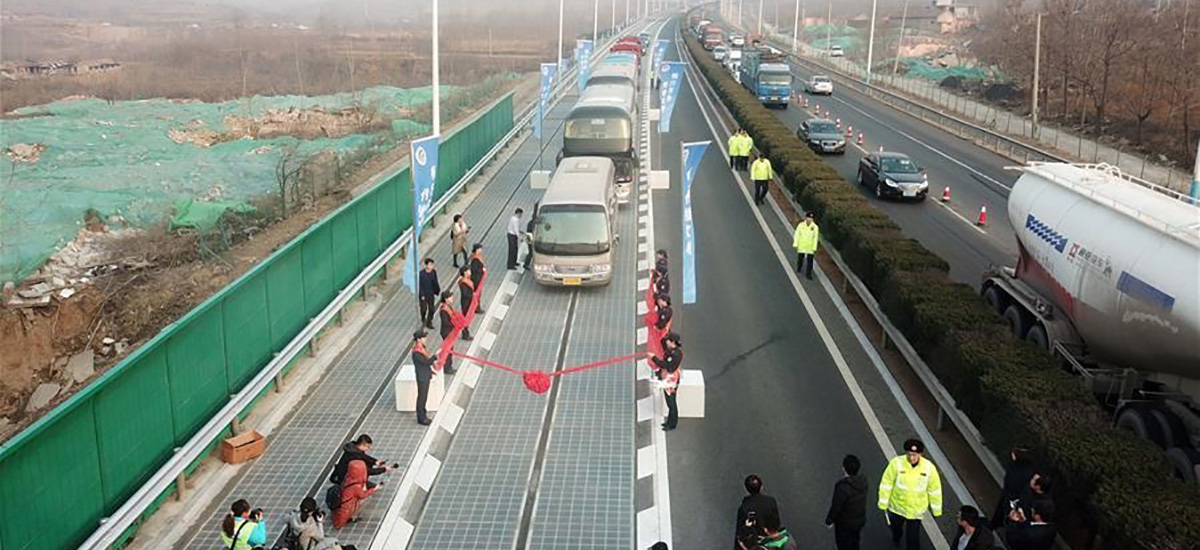
 Your Credit Estimate
Your Credit Estimate
 Your Credit
Your Credit
Your zip code helps us provide you with the most accurate vehicle pricing and vehicle availability.
We estimate your credit score to give you an idea of your monthly payments. To get an accurate payment amount, complete our credit application by clicking the Start Credit Application button below.
start credit application
Our friends in the East have always been ahead of the game, but this one practically takes the cake. In December 2017, China opened a solar-powered road to the public. Measured to be 1-kilometer long, the solar road can be found in Jinan, the capital of Shandong province south of Beijing. But wait, a solar road? A road powered by the sun? That doesn’t make any sense, since when does asphalt have anything to do with the sun? Well, it’s not so much a road that’s powered by the sun, but more so a road that is charged up by the sun.
See where this is going?
Made up of two lanes, the solar road covers 5,875 square meters and can generate up to one million kilowatt-hours of power per year. That’s enough power for 800 family homes in China. We’d like to think that would make electric bills drop or that the energy would be free to use, but we can’t see funding going into this to not make a profit. After all, the Chinese solar road cost $458 per square meter — that’s roughly 90 times the cost of a traditional asphalt road. So the jury on whether this solar electric highway is cost-effective is still figuring out that one.
For now, to test the productivity of the solar road, the electricity generated will be used to run street lights, billboards, surveillance cameras, and toll collection plazas. As an added bonus, during the winter season, the solar road will be used to heat the road surface to keep it clear of snow. Any excess energy generated will be fed back into the local utility grid.
We know what you’re thinking. A road made out of solar panels sounds costly and impractical - they’ll shatter with all that weight! And you’d be right. That’s why the surface of China’s solar road is made out of transparent concrete that can withstand 10 times more pressure than regular concrete, according to Slate Magazine. It is beneath this transparent concrete covering that the solar panels are installed. There, they convert sunlight into electricity. In addition, under the solar panels is an insulating layer designed to protect them from excessive heat or cold as a safeguard. Can’t have a solar road catching fire from a lightning strike or overheating.
We’re thinking maybe the Qilu Transportation Development Group, the infrastructure construction company behind the production of the solar road should give Mitsubishi Motors a call. Maybe even Kia Motors. We think the three parties could benefit from one another. Both, Mitsubishi Motors and Kia Motors have started new projects involving solar panels and electricity and how they can be used to charge vehicles.
Recently, Mitsubishi Motors, in conjunction with Hitachi Europe and ENGIE, tested and essentially created renewable, neutral, free energy. In a nutshell, ENGIE has their headquarters office building in La Défense, France. Known as a Building Energy Management System (BEMS), ENGIE headquarters are powered with electricity converted from solar energy collected from solar panels installed around the building. Excess energy is stored into the building electrical grid, but with this new project with Mitsubishi and Hitachi, the excess energy is instead discharged through Hitachi’s V2X bi-directional charger that then discharges the electricity into a unit of the Mitsubishi Outlander PHEV to charge up its 12 kWh lithium-ion battery. During the day, the plug-in hybrid acts as a portable energy storage unit, and at night, the electricity can then be discharged back through the V2X charger into the ENGIE building. Couldn’t the same be done with the solar road?
Well, no, not if there are cars constantly moving on it. And so then we have Kia Motors, currently developing wireless electric vehicle charging. Simply put, an electric vehicle or plug-in hybrid can be outfitted with a compact wireless charging receiver that then pairs with an electromagnetic field generator. That generator collects all of the free electrons in the surrounding area and then converts it into electricity. Via a transmitter in the generator, all an EV or plug-in hybrid need to do is drive over it, and the installed receiver is charged up by the generator (able to collect up to 10 kW).
So maybe if the solar road proves to be cost-effective, the next step would be to divert the excess energy into electromagnetic generators and turn the solar road into an energy plant for the city as well as an ongoing electric vehicle charging station. On a sunny day, surely there’s enough energy to power more than a couple of city lights.
With all of this goodness happening in the East, we’re starting to wonder what’s holding North America behind. Those of us in the West would like to step into the future too. Follow us on NowCar social media for more information as it’s made available.